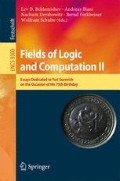Abstract
A remarkable achievement in algorithmic randomness and algorithmic information theory was the discovery of the notions of \(\textit{K}\)-trivial, \(\textit{K}\)-low and Martin-Löf-random-low sets: three different definitions turn out to be equivalent for very non-trivial reasons [1, 3, 5]. This survey, based on the course taught by one of the authors (L.B.) in Poncelet laboratory (CNRS, Moscow) in 2014, provides an exposition of the proof of this equivalence and some related results.
We assume that the reader is familiar with basic notions of algorithmic information theory (see, e.g., [7] for introduction and [8] for more detailed exposition). More information about the subject and its history can be found in [2, 6].
Access this chapter
Tax calculation will be finalised at checkout
Purchases are for personal use only
Notes
- 1.
A technical remark: note that in our description of the game we have required that the opponent’s weight along the path is strictly greater than our weight: if this is true in the limit, it happens at some finite stage.
- 2.
To use infinite sets as parameters, we should restrict ourselves to some class of infinite sets. For example, we may consider infinite decidable sets and represent them by programs enumerating their elements in increasing order.
- 3.
Formally speaking, we construct two semimeasures on integers; to avoid confusion, it is convenient to call their arguments “lengths” and “objects”.
- 4.
The pedantic reader may complain that the parameter is an infinite set. It is in fact enough to consider infinite sets from some class, say, decidable sets (as we noted in the previous section), or just arithmetic progressions. Such sets are enough for our purposes and have finite representation. Indeed, an arithmetic progression can be split into countably many arithmetic progressions. For example, \(1,2,3,4,\ldots \) can be split into \(1,3,5,7,\ldots \) (odd numbers), \(2,6,10,14\ldots \) (odd numbers times 2), \(4,12,20,28,\ldots \) (odd numbers times 4), etc.
- 5.
This was to be expected. The relation \(a\mathrel {\leqslant _{\text {LK}}}b\) is quantitative: it states that two functions coincide with O(1)-precision; whether the relation \(a\mathrel {\leqslant _{\text {LR}}}b\) holds, on the other hand, is a qualitative yes/no question. One can also consider the quantitative version, with randomness deficiencies, but this is unnecessary: the relation \(\mathrel {\leqslant _{\text {LR}}}\) is already strong enough to obtain an equivalence.
References
Downey, R., Hirschfeldt, D., Nies, A., Stephan, F.: Trivial reals. In: Downey, R., Decheng, D., Ping, T.S., Hui, Q.Y., Yasugi, M. (eds.) Proceedings of the 7th and 8th Asian Logic Conferences, pp. 103–131. Singapore University Press and World Scientific, Singapore (2003)
Downey, R., Hirschfeldt, D.: Algorithmic Randomness and Complexity. Springer, New York (2010)
Hirshfeldt, D., Nies, A., Stephan, F.: Using random sets as oracles. J. Lond. Math. Soc. 75, 610–622 (2007)
Kjos-Hanssen, B., Miller, J., Solomon, R.: Lowness notions, measure and domination. J. Lond. Math. Soc. 85(3), 869–888 (2012)
Nies, A.: Lowness properties and randomness. Adv. Math. 197, 274–305 (2005)
Nies, A.: Computability and Randomness. Oxford University Press, Oxford (2009)
Shen, A.: Algorithmic information theory and Kolmogorov complexity, lecture notes, Uppsala University Technical report TR2000-034. http://www.it.uu.se/research/publications/reports/2000-034/2000-034-nc.ps.gz
Shen, A., Uspensky, V., Vereshchagin, N.: Kolmogorov complexity and algorithmic randomness. MCCME (2012) (Russian). Draft translation: www.lirmm.fr/ashen/kolmbook-eng.pdf
Acknowledgments
This exposition was finished while one of the authors (A.S.) was invited to the National University of Singapore IMS’s Algorithmic Randomness program. The authors thank the IMS for the support and for the possibility to discuss several topics (including this exposition) with the other participants (special thanks to Rupert Hölzl and Nikolai Vereshchagin; R.H. also kindly looked at the final version and corrected many errors there). We also thank André Nies for the suggestion to write down this exposition for the Logic Blog and for his comments. We have very useful discussions with the participants of the course taught by L.B. at the Laboratoire Poncelet (CNRS, Moscow), especially Misha Andreev and Gleb Novikov. Last but not least, we are grateful to Joe Miller who presented the proof of the equivalence between \(\mathrel {\leqslant _{\text {LK}}}\) and \(\mathrel {\leqslant _{\text {LR}}}\) while visiting the LIRMM several years ago.
Author information
Authors and Affiliations
Corresponding author
Editor information
Editors and Affiliations
Rights and permissions
Copyright information
© 2015 Springer International Publishing Switzerland
About this chapter
Cite this chapter
Bienvenu, L., Shen, A. (2015). \(\textit{K}\)-trivial, \(\textit{K}\)-low and \({{\mathrm{\textit{MLR}}}}\)-low Sequences: A Tutorial. In: Beklemishev, L., Blass, A., Dershowitz, N., Finkbeiner, B., Schulte, W. (eds) Fields of Logic and Computation II. Lecture Notes in Computer Science(), vol 9300. Springer, Cham. https://doi.org/10.1007/978-3-319-23534-9_1
Download citation
DOI: https://doi.org/10.1007/978-3-319-23534-9_1
Published:
Publisher Name: Springer, Cham
Print ISBN: 978-3-319-23533-2
Online ISBN: 978-3-319-23534-9
eBook Packages: Computer ScienceComputer Science (R0)

